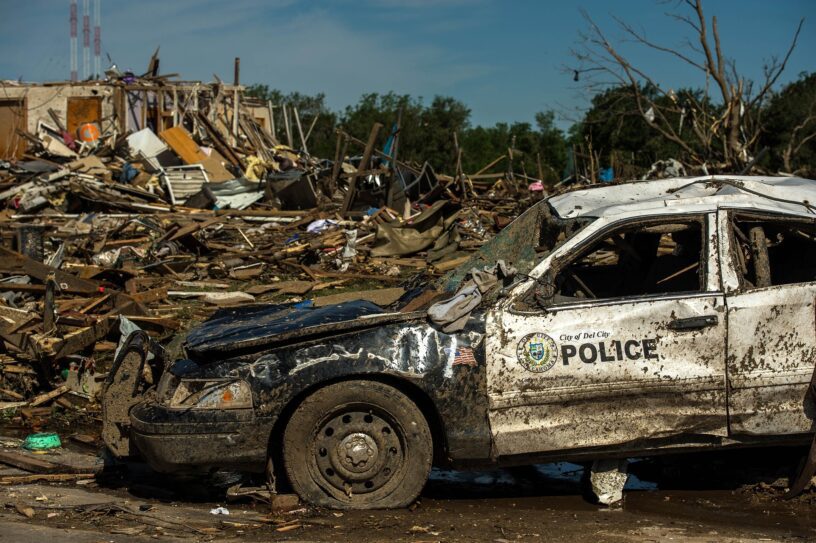
Image by David Mark from Pixabay
10 Deadliest Natural Disasters in The History Of Texas
Texas is diverse with geography that ranges from coastal plains to mountains and deserts. When it comes to natural disasters Texas has had them. From hurricanes to floods, the dark side of Mother Nature has visited the Lone Star State. The Galveston Hurricane is one such event. The drought of the 1950s was also a significant disaster, causing widespread crop failures and leading to massive dust storms. In 1979, Tropical Storm Claudette dumped more than 45 inches of rain on Alvin, Texas, causing severe flooding and killing 30 people. These events serve as reminders of the power of nature and the importance of preparedness and response efforts. Significant loss of life and property damage and a lasting impact is the effect of the calamities. Read this article to learn about the 10 deadliest natural disasters in the history of the Lone Star State.
Hurricanes
Brownsville Hurricane – 1867

Image by Welcome to All ! ツ from Pixabay
Every year, approximately one hundred tropical disturbances are created over the Atlantic Ocean, Caribbean Sea and Gulf of Mexico. About fifteen of these become tropical depressions. Of the fifteen, ten become tropical storms and 5 become hurricanes. About every fifty years, one of these extremely intense hurricanes strikes the US with disastrous consequences. In the history of Texas history, Brownsville Hurricane is one of the most devastating natural disasters, it is also known as the Hurricane of 1867.
Winds of up to 130 mph and a deluge that dumped lots of rain in a short time quickly flooded the town. Rooftops became safe havens for most of the residents. Farms, businesses and homes bore the brunt of the hurricane’s destructive power. It is, without doubt, the most destructive ever hurricane to strike Texas. The gale-force winds uprooted century-old trees. Unfortunately, over 1,800 people lost their lives after the search and rescue efforts were declared officially over.
Galveston Hurricane – 1900

Image from Wikimedia
The arrival of a hurricane on September 8, 1900, wiped out Galveston; the grandest city in Texas then. The Galveston Hurricane was deadly: the deadliest than any other in United States history. It took with it an estimated 6,000* to 12,000* lives. Its topography as a low-lying island made it vulnerable to storm surges and flooding. The city was ill-prepared for the strength of the hurricane despite weather forecasts and warnings. A 15-foot storm surge caused the floods that destroyed buildings. So devastating was the hurricane of 1900, it’s been estimated that nearly one-fourth of the city’s population died. The inventor Thomas Edison sent a cameraman who arrived several days after the storm had struck. This remarkable record of the disaster is believed to be the first-ever news film. To mitigate the elevation of the island was raised and a seawall was built to protect against future storms.
Hurricane Harvey – 2017
Hurricane Harvey in August 2017 spelt doom for Texas, for it caused the costliest natural disaster in United States history. 68 people and an estimated $125 billion in damages is the true cost of the hurricane. The effects of Hurricane Harvey were devastating for many Texans. The flooding displaced over 30,000 people. In addition to physical damage, many businesses suffered financially due to lost revenue from closed stores and disrupted supply chains. The state’s energy infrastructure was extensively damaged leading to shortages of gasoline and other petroleum products. The Houston Ship Channel, one of the busiest ports in the world was shut down. The shipping industry was also affected. Harvey’s slow-moving nature meant that it lingered over Texas for days and the effects are still felt to date.
15 Scary things to Know about Hurricanes.
Tornadoes
Waco Tornado – 1953

Image by Billy Hawthorne from Wikimedia
The Waco tornado killed 114 people and injured 597 more. It destroyed over 600 homes and damaged thousands more. In 1953 there was an outbreak of tornadoes across the central United States. Apart from killing hundreds of people, it caused widespread damage. The Waco tornado was rated F5 on the Fujita scale, the most powerful rating possible. The tornado hit the western edge of Waco after moving from its origin in the southwest of the city. The tornado then continued on a northeast path, passing through the downtown area of the city before dissipating. A massive relief effort led by the Red Cross and the National Guard was launched to help those affected by the storm. Donations of money and supplies were received assistance from across the country.
Dallas Tornado – 1957
One of the worst natural disasters in Texas history was the 1957 Dallas Tornado. Communications and power were disrupted. It destroyed hundreds of homes, businesses and vehicles. The cyclone was designated F3 on the Fujita scale and had wind speeds of 206 mph. The storm only lasted for about 30 minutes but its effects were felt much longer. Furthermore, there was an estimated $12 million in property damage. The disaster response was led by local authorities. As if Mother Nature was reminding us of its power. It was one of the most devastating tornadoes ever recorded in Texas. The Dallas Tornado of 1957 remains one of the most significant natural disasters in the city’s history and serves as a reminder of the destructive power of tornadoes and the importance of preparedness and response efforts.
Tornado drills and preparedness plans are now in place throughout Texas, with the goal of minimizing damage from similar disasters. Although nothing can completely prevent destruction from these powerful storms, knowing what to do when a tornado approaches can make a difference. It’s important to create an emergency plan and be familiar with potential safe havens in your area. The Dallas Tornado of 1957
Related Read: 15 Scary Facts about Tornadoes.
Lubbock Tornado – 1970

damaged cell phone tower and power poles. image by NWS Lubbock TX from Wikimedia
Portions of Lubbock, Texas, were struck by a powerful multiple-vortex tornado in May 1970, resulting in 26 fatalities. The storm caused around $500 million (in 1970 dollars) in damages. The tornado touched down at around 9:45 PM near the Lubbock Preston Smith International Airport and quickly intensified into an F5 tornado, the most powerful category of tornado. The tornado was one mile wide and the track length was eight miles.
No wonder it caused such widespread destruction in Lubbock. Recorded as destroyed were many homes and businesses. The Lubbock Tornado was a pivotal event in the history of tornado forecasting and warning. Earlier in the day The National Weather Service had issued a tornado watch. Surprisingly, there were no tornado warnings in effect when the Lubbock Tornado struck. The storm caught many residents off guard and thus they were unprepared.
Floods
Gulf Coast Flood – 1929
Texas’ economy and society were significantly affected by the 1929 Gulf Coast Flood, particularly in the state’s southeast. The devastating natural disaster known as the 1929 Gulf Coast Flood took place in late September and early October. It was brought about by a progression of typhoons and storms that hit the Inlet Coast locale of the US, especially the provinces of Florida, Alabama, Mississippi and Louisiana. Texas was also affected by the 1929 Gulf Coast Flood, which was most severe in Louisiana.
About 1000 lives were lost to the floods. The flooding had a particularly devastating effect on the Texas-Louisiana border communities of Orange and Beaumont. The Neches River overflowed its banks in Orange, causing widespread damage to public buildings, businesses and homes. In Beaumont, the flooding was especially serious in the city’s African American areas, which were situated in low-lying regions.
15 Scary Facts about Climate Change.
Memorial Day Flood – 1981

The damage caused by Austin’s second Memorial Day flood in 2015 was similar to what happened in 1981. Image by City of Austin from Wikimedia
Forty-two years ago during Memorial Day weekend, a devastating flood ravaged Austin. A series of thunderstorms caused flash flooding in the Houston area. The flood killed 15 people and caused significant damage to homes and infrastructure. It was a devastating natural disaster that struck the Texas Hill Country region on May 24, 1981. 10 inches of rain in a few hours led to the Guadalupe River bursting its banks. The swift currents of the Guadalupe River swept away homes, cars, and entire buildings, while the Comal River flooded nearby neighbourhoods and caused extensive damage to local businesses. The floodwaters were so powerful that they even destroyed the historic Faust Street Bridge, which had stood for over 80 years. With damage estimates reaching over $500 million, The Memorial Day Flood is one of the deadliest and costliest floods in Texas history. The National Flood Insurance Program was created following the disaster.
San Antonio Flood – 1921
In September 1921, a hurricane caused significant flooding in the San Antonio area. The culprit? 23 inches of rain in the area in just 36 hours dumped by a slow-moving tropical storm. The s flood caused causing the San Antonio River and its tributaries to overflow. The areas of downtown San Antonio, particularly the low-lying areas along the river, were particularly hard-hit. The city’s water and power plants were victims of the floodwaters. Hence there was no clean drinking water or electricity for days. The flood took an estimated 50 and 100 people. $5* million (equivalent to over $70* million today) worth of damage left many homeless. To prevent a similar disaster from occurring again a series of dams and flood-control measures were implemented.
Related Read: 15 Alarming Facts about Global Warming.
Wind
Delta Airlines Flight 191 Crash – 1985

Image by Pedro Augusto B. Medeiros from Wikimedia
On August 2, 1985, the Lockheed L-1011 Tristar operating the flight crashed while attempting to land at Dallas/Fort Worth International Airport, killing 137 of the 163 people on board and one person on the ground. A microburst occurred as the aircraft approached the airport. This is a sudden, violent air current that causes the aircraft to lose altitude rapidly. After the pilot attempted to recover from wind shear, the aircraft struck a highway overpass just short of the runway.
The air traffic control system at the time did not adequately warn of dangerous weather conditions. Worse still the pilots were not sufficiently trained to deal with wind shear. Significant changes have been made to flight safety techniques and procedures. Since then, the creation of an improved wind shear detection and warning system and the training of pilots has been adopted. One of his worst aviation disasters in US history, Delta Air Lines Flight 191 is a reminder of the importance of continuous safety improvement.
Natural disasters have had a significant impact on Texas throughout its history. From hurricanes and tornadoes to floods and explosions, these disasters have caused significant loss of life and property damage. However, Texas has shown resilience in the face of adversity, rebuilding and recovering from these disasters. Preparing and protecting against future disasters is a priority since the state continues to face the threat of natural disasters.
Planning a trip to Paris ? Get ready !
These are Amazon’s best-selling travel products that you may need for coming to Paris.
Bookstore
- The best travel book : Rick Steves – Paris 2023 – Learn more here
- Fodor’s Paris 2024 – Learn more here
Travel Gear
- Venture Pal Lightweight Backpack – Learn more here
- Samsonite Winfield 2 28″ Luggage – Learn more here
- Swig Savvy’s Stainless Steel Insulated Water Bottle – Learn more here
Check Amazon’s best-seller list for the most popular travel accessories. We sometimes read this list just to find out what new travel products people are buying.











